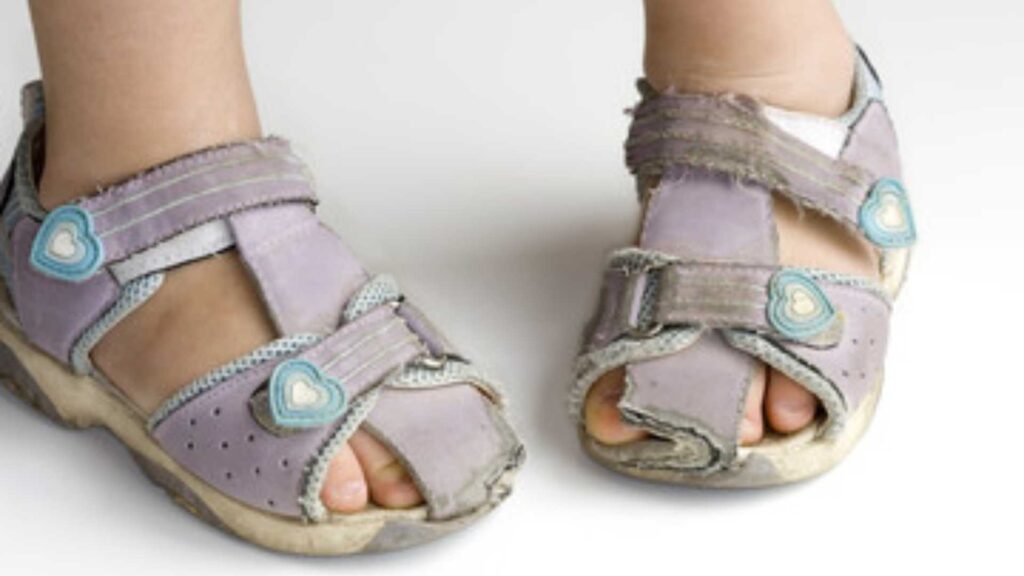What Is In-toeing?
In-toeing, commonly known as pigeon-toed gait, is a condition where a child’s feet point inward instead of straight while walking or running. It is a common condition in children, with most cases resolving naturally by age 8 or early teenage years. In-toeing is usually painless, but in some cases, intervention may be required to correct severe misalignments or associated complications.
Causes of In-toeing
-
Metatarsus Adductus
– The front part of the foot curves inward, typically caused by limited space in the womb during development.
– Visible at birth or soon after. -
Tibial Torsion
– The shinbone twists inward, often becoming noticeable when a child starts walking.
-
Femoral Anteversion
– The thighbone rotates inward, causing knees and feet to point inward. This condition usually appears by age 5–6.
Symptoms of In-toeing
- Visible inward turning of one or both feet during rest or motion.
- Frequent tripping or falling while walking or running.
- Clumsiness during physical activities.
- In severe cases, knees may also turn inward.
How Is In-toeing Diagnosed?
- Observation of walking and standing patterns by a podiatrist.
- Physical examinations of the feet, knees, and hips for alignment or rotation issues.
- X-rays or additional imaging may be recommended to confirm the cause and severity.
Treatment Options for In-toeing
- Mild Cases: Often resolves naturally with growth.
- Moderate to Severe Cases:
- Casting or Bracing: For infants with metatarsus adductus.
- Semi Custom or Custom Orthotics: Insoles with an out-toe gait plate are prescribed to correct posture and alignment.
- Physiotherapy: Exercises to address misalignment and improve gait.
- Surgery: Rarely needed, reserved for severe deformities that do not improve with other treatments.
What Happens If Left Untreated?
- Persistent tripping and clumsiness.
- Potential for joint or muscle pain later in life.
- Increased risk of postural deformities like scoliosis or lordosis.
- Possible self-consciousness due to visible gait abnormalities.
In-toeing Prevention Tips
- Discourage sitting in the ‘W’ position, which can worsen rotational deformities.
- Encourage good posture and regular physical activity.
- Use supportive footwear that promotes proper alignment.
- Seek early intervention if gait abnormalities are noticeable.
Why Choose Physio & Sole Clinic & Women And Children Centre (WACC)?
At Physio & Sole Clinic, we specialise in paediatric podiatry, focusing on correcting gait abnormalities like in-toeing. Our experienced podiatrists provide thorough lower limb assessments and personalised treatment plans tailored to your child’s needs. By combining advanced diagnostic tools, physiotherapy, and orthotic solutions, we ensure a holistic approach to improving your child’s posture and gait, helping them grow into healthy, confident individuals.
To schedule an appointment, book here or WhatsApp us here
Frequently Asked Questions
In-toeing rarely leads to serious complications but may result in joint or muscle discomfort if uncorrected.
Consult a podiatrist if in-toeing is severe, causes frequent tripping, or persists beyond the age of 8.
Mild cases often resolve naturally by the age of 8. For moderate to severe cases, the duration depends on the treatment plan and severity.
Children with pigeon toed gait can exercise normally especially since the condition rarely causes pain. The most common issue with children suffering from pigeon-toed gait may trip more often than others during exercise. The tendency of this happening tends to decrease before their toes become fully corrected with treatment.
Podiatry Charges
| Podiatry Assessment | $190 |
| Follow-Up Podiatry Consultation | $80 |
| Semi Custom Foot Orthoses | $450 |
| Customised Foot Orthoses | $700 |
| Manual Therapy | $40 |
All prices are before GST.
Please note that charges may vary depending on the treatment plan prescribed by your Podiatrist. Our charges are transparent and rest assured there are no hidden charges. A podiatry session will last for 30-45 minutes. There are no surcharges if your session exceeds 45 minutes.
For more information on podiatric charges and insurance inquiries, visit us here or get in touch with us here.
Related Articles:



